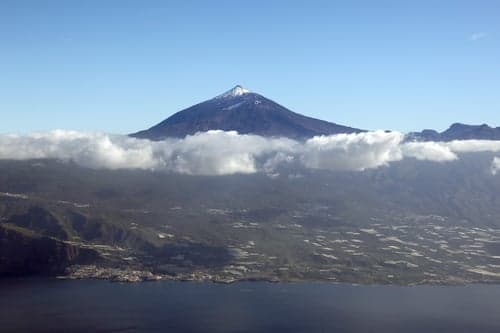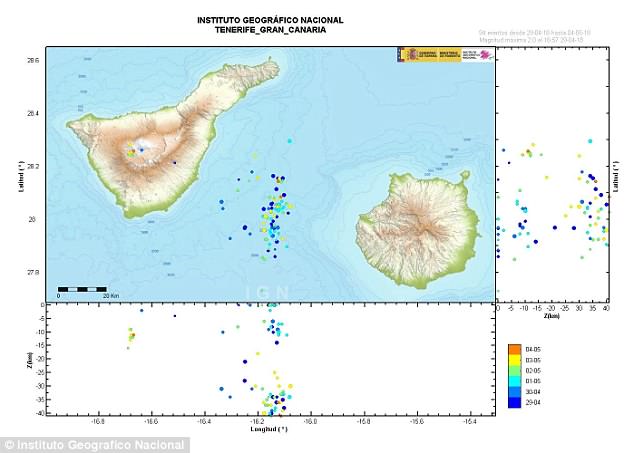Don't panic: Tenerife's volcano ISN'T about to blow

Vulcanologists have urged calm after a spate of alarming headlines from British tabloids warning that Tenerife's Mount Teide could be about to erupt.
The headlines came after seismologists recorded a series of over 270 mini-earthquakes in a 10 day period beginning on April 29th.

The seismic activity was seized on by certain tabloids as evidence that Tenerife's Mount Teide, the volcano that dominates the Canary Islands skyline, was about to erupt for the first time in more than a century.
The Daily Express chose to illustrate the article with dramatic images of red hot lava pouring down the side of a volcano and blocking roads. The footage was taken after the recent eruption by Kilauea volcano in Hawaii.
Tenerife volcano alert: Shock as 270 earthquakes hit Brit holiday favourite Canary Islands https://t.co/jYLA5FTwK3 pic.twitter.com/h6Po9H0mgC
— Daily Express (@Daily_Express) May 8, 2018
The Daily Star used similar images for their article warning: “MEGA-ERUPTION fears: 270 earthquakes rock Brit holiday hotspot”.
#Tenerife #volcano #MEGA-#ERUPTION fears: 270 #earthquakes rock #Brit holiday hotspot https://t.co/HZibjR79kX
— Michael Conti (@ImperioMundial) May 8, 2018
The Daily Mail also ran the story.
@SimonTurkas @JohnBeckley I can't stand take useless news like this that sparks unnecessary fear ??
Fears of deadly eruption on popular Tenerife holiday spot https://t.co/6lXiptnG2t via @MailOnline
— Kate Louise M. (@KateLouise_2812) May 9, 2018
But Canary Island authorities were outraged at the scaremongering and sought to set the record straight.
“It's absolutely safe to come to Tenerife Island,” insisted David Calvo from Involcan, the Canarian Institute of Vulcanology.
He explained that seismic swarms were completely normal activity in the region and did not signify an imminent volcanic eruption.
“There is no increase in the volcanic alert level at Tenerife due to the recent seismic swarm between Tenerife and Gran Canaria. New reports that suggest otherwise have no basis in fact and are to be dismissed,” read a statement issued by Involcan.
En relación a las falsedades que algunos tabloides Británicos están divulgando sobre un incremento de la alerta volcánica en Tenerife y que algunos medios están contribuyendo a diseminar, el Instituto Volcanológico de... https://t.co/E98GlryAfZ
— INVOLCAN (@involcan) May 9, 2018
The mini-quakes were not even felt by residents and are only detectable by sensitive seismology instruments.
“The Canary Islands are considered an active volcanic region, and also an attractive tourist destination, partly because of the volcanism which has built them. It is normal for these active volcanic systems to produce small earthquakes. They are so small, only sensitive instruments, called seismometers, can detect them.
“Seismic swarms are clusters of these tiny earthquakes together in time. They are common in active volcanic areas, even during quiescent periods, as the one recorded from April 29 to May 3, 2018, between Tenerife and Gran Canaria islands by the seismometers of the Canary Islands Volcanological Institute (INVOLCAN).”
Involcan explained that no signs of deformation at Teide volcano had been detected and therefore no movement of magma under the volcano, meaning that the quakes are not an early warning of an eruption caused by an upwelling of magma.
But they assured that close monitoring means early danger would be detected.
“There is a Special Plan of Civil Protection and emergency response for volcanic risk in the Canary Islands (PEVOLCA) in place. The volcano alert level is in the GREEN position. This status means people can be confident to carry out their activities normally.”
With a summit of 3,718-metres Mount Teide is Spain's highest peak and last erupted in 1909.
Each year, thousands of visitors take the cable car or make the five hour climb to its peak where they can walk around in the crater.
Tourism chiefs warned that untrue reports that the volcanco was about to blow could have a damaging effect on visitor numbers to the island.
"The Tenerife Tourism Corporation advises obtaining information exclusively from official sources rather than from sensationalist articles to avoid unnecessary fear and confusion," a spokesman said.
Comments
See Also
The headlines came after seismologists recorded a series of over 270 mini-earthquakes in a 10 day period beginning on April 29th.

The seismic activity was seized on by certain tabloids as evidence that Tenerife's Mount Teide, the volcano that dominates the Canary Islands skyline, was about to erupt for the first time in more than a century.
The Daily Express chose to illustrate the article with dramatic images of red hot lava pouring down the side of a volcano and blocking roads. The footage was taken after the recent eruption by Kilauea volcano in Hawaii.
Tenerife volcano alert: Shock as 270 earthquakes hit Brit holiday favourite Canary Islands https://t.co/jYLA5FTwK3 pic.twitter.com/h6Po9H0mgC
— Daily Express (@Daily_Express) May 8, 2018
The Daily Star used similar images for their article warning: “MEGA-ERUPTION fears: 270 earthquakes rock Brit holiday hotspot”.
#Tenerife #volcano #MEGA-#ERUPTION fears: 270 #earthquakes rock #Brit holiday hotspot https://t.co/HZibjR79kX
— Michael Conti (@ImperioMundial) May 8, 2018
The Daily Mail also ran the story.
@SimonTurkas @JohnBeckley I can't stand take useless news like this that sparks unnecessary fear ??
— Kate Louise M. (@KateLouise_2812) May 9, 2018
Fears of deadly eruption on popular Tenerife holiday spot https://t.co/6lXiptnG2t via @MailOnline
But Canary Island authorities were outraged at the scaremongering and sought to set the record straight.
“It's absolutely safe to come to Tenerife Island,” insisted David Calvo from Involcan, the Canarian Institute of Vulcanology.
He explained that seismic swarms were completely normal activity in the region and did not signify an imminent volcanic eruption.
“There is no increase in the volcanic alert level at Tenerife due to the recent seismic swarm between Tenerife and Gran Canaria. New reports that suggest otherwise have no basis in fact and are to be dismissed,” read a statement issued by Involcan.
En relación a las falsedades que algunos tabloides Británicos están divulgando sobre un incremento de la alerta volcánica en Tenerife y que algunos medios están contribuyendo a diseminar, el Instituto Volcanológico de... https://t.co/E98GlryAfZ
— INVOLCAN (@involcan) May 9, 2018
The mini-quakes were not even felt by residents and are only detectable by sensitive seismology instruments.
“The Canary Islands are considered an active volcanic region, and also an attractive tourist destination, partly because of the volcanism which has built them. It is normal for these active volcanic systems to produce small earthquakes. They are so small, only sensitive instruments, called seismometers, can detect them.
“Seismic swarms are clusters of these tiny earthquakes together in time. They are common in active volcanic areas, even during quiescent periods, as the one recorded from April 29 to May 3, 2018, between Tenerife and Gran Canaria islands by the seismometers of the Canary Islands Volcanological Institute (INVOLCAN).”
Involcan explained that no signs of deformation at Teide volcano had been detected and therefore no movement of magma under the volcano, meaning that the quakes are not an early warning of an eruption caused by an upwelling of magma.
But they assured that close monitoring means early danger would be detected.
“There is a Special Plan of Civil Protection and emergency response for volcanic risk in the Canary Islands (PEVOLCA) in place. The volcano alert level is in the GREEN position. This status means people can be confident to carry out their activities normally.”
With a summit of 3,718-metres Mount Teide is Spain's highest peak and last erupted in 1909.
Each year, thousands of visitors take the cable car or make the five hour climb to its peak where they can walk around in the crater.
Tourism chiefs warned that untrue reports that the volcanco was about to blow could have a damaging effect on visitor numbers to the island.
"The Tenerife Tourism Corporation advises obtaining information exclusively from official sources rather than from sensationalist articles to avoid unnecessary fear and confusion," a spokesman said.
Join the conversation in our comments section below. Share your own views and experience and if you have a question or suggestion for our journalists then email us at [email protected].
Please keep comments civil, constructive and on topic – and make sure to read our terms of use before getting involved.
Please log in here to leave a comment.